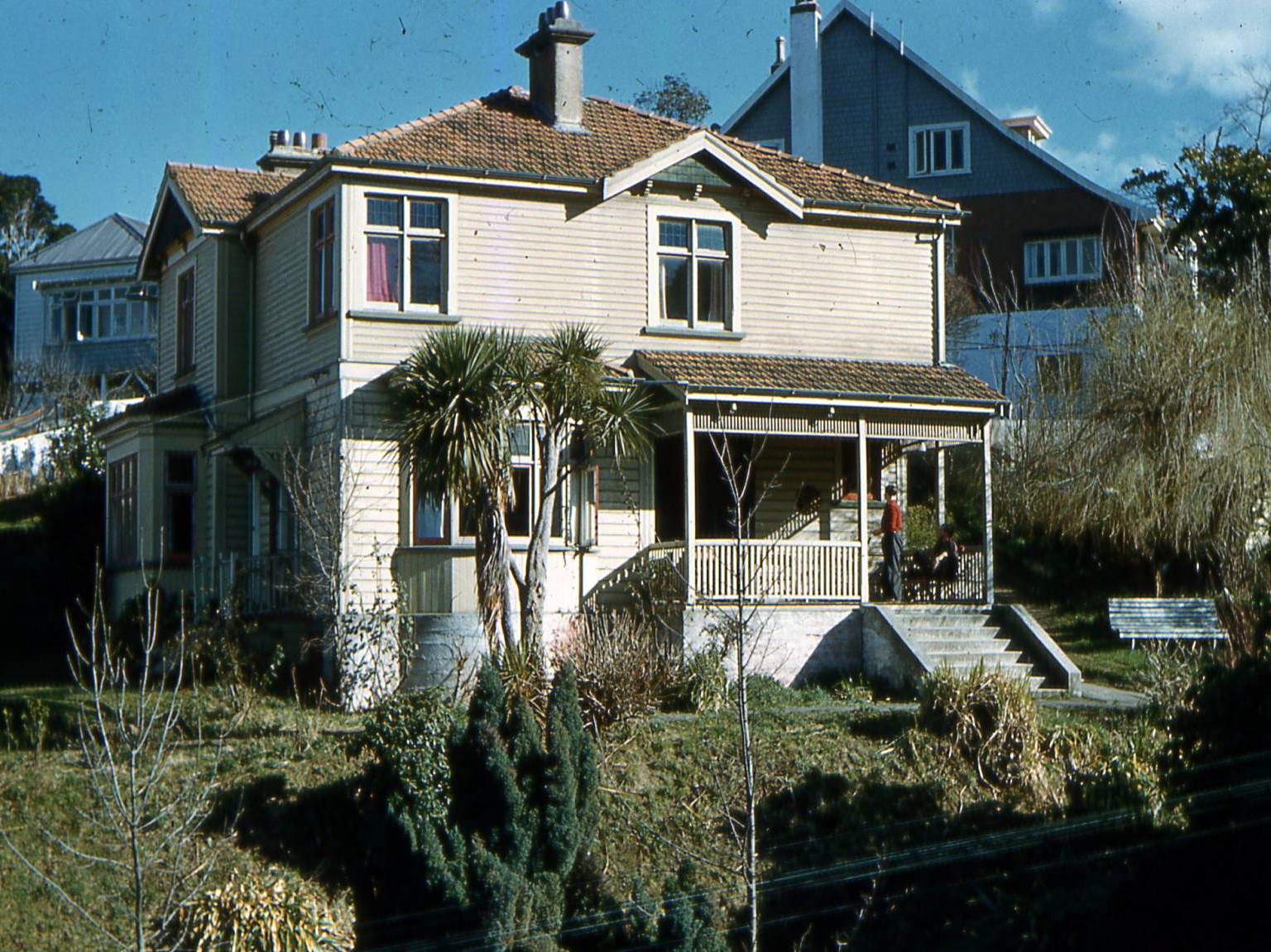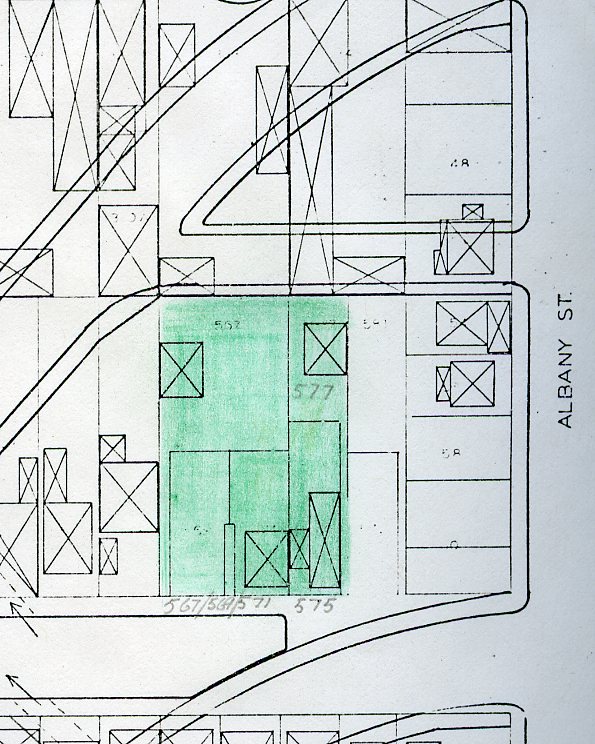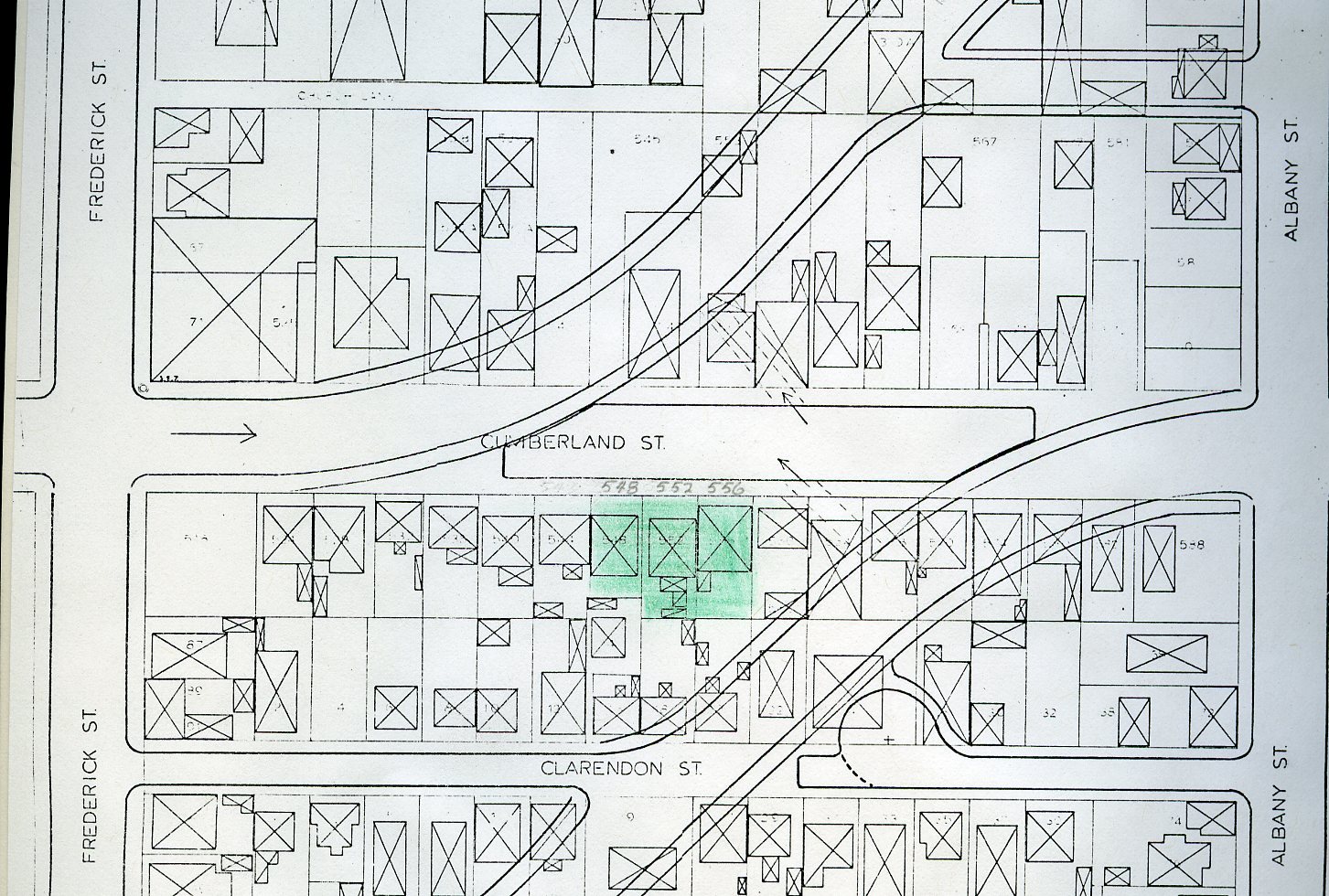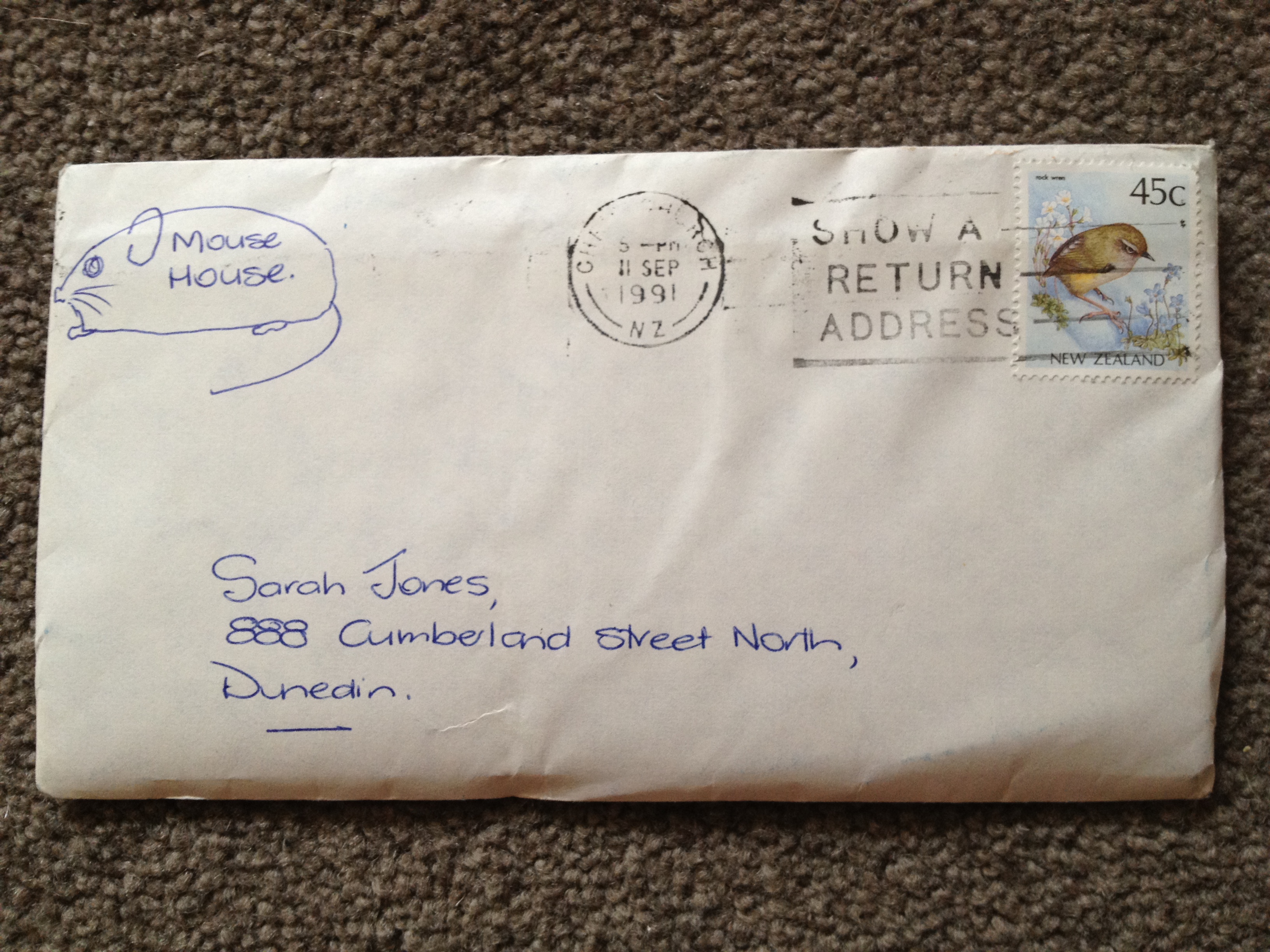Category: 1970s
Department of Slavonic Studies
In 1972 at 72 St David Street, where the St David Street lecture theatres sit now, a group of students hung out a rather official looking sign. It celebrated their “three common kiwi names”, Fudakowski, Nowakowski, Voykovic. As the flat was owned by the University name it made sense to call it, “Department of Slavonic Studies”. Mike Fudakowski told me, “We had a formal-looking plate made for the door by a relative of Anthony Voykovic, one Gary Wyber who with his father had a photographic printing business and could photo-etch a zinc plate. Voykovic thinks that Nowakowski ended up with that plate. I don’t remember.”
The flat cost a grand total of $5 a week. Average at the time. It had a coal range and a gas oven, so it wasn’t too difficult to warm in winter. However it had no hot water at all. “We used to venture down the road to the Student Union or the Phys Ed School squash courts for a shower, so this may not have occurred on a daily basis.”

Paula Worthington, Mike Fudakowski, Andrew Nowakowski and Tony Voykovic with the ‘Staff Car’. Photograph by Nigel Charters, used with permission.
Kasia Waldegrave who provided the photo, told me the flat was visited by the New Zealand Security Intelligence Service (NZSIS), the name having sparked fears of a communist domino effect having infiltrated Dunedin. Mike didn’t recall this incident, but did remember another. “We were certainly visited by a Polish-speaking gentleman who said he was the Polish Consul from Wellington on a visit. A mystified man, puzzled by my own evident inadequacy with the Polish tongue. Nowakowski was called and came to the rescue to explain that the Department was only informally attached to the University. I think he knew the Polish words for “student humour”.”
Curious about the NZSIS visit, I wrote them a letter. They checked their records, but there were no details of an investigation into the inhabitants of the Department of Slavonic Studies.
The flat possessed a small, asphalted back yard from which they could see, on Cumberland Street, the rear of “Free Latvia”, a flat where Jim Mora, Radio NZ broadcaster, used to live.

Critic 1977, vol. 53, no. 5, p.14
Toad Hall addendum to “Scarfie Flats of Dunedin”
It’s the fate of authors investigating and relaying stories from the past; details will be missed, stories will be untold and some facts may be incorrectly reported. So much of this kind of research relies on finding people, or being found. It relies on getting in touch with, or hearing the people that lived there at the time, or who knew someone (who knew someone) – but sometimes that just doesn’t happen at all, or in the case of Toad Hall, didn’t happen in time.
In September 2019, Jim Scott submitted reminiscences about his time at Toad Hall, a time that began in late 1958. The story of Toad Hall features on pages 54-59, 22 and 238 of Scarfie Flats of Dunedin and describes the beginnings of the flat in the 1960s. Many thanks Jim, for getting in touch and contributing to the story of Toad Hall. Scarfie Flats of Dunedin was a snapshot in time, its great to continue the story here, online.
Toad Hall origin story
After three years of residence in Knox College, we five: John Allen [Medicine], George Salmond [Medicine], Fred Strange [Medicine], Jim Scott [Dentistry], and Lachie Watson [Law], left at the end of 1958 to “go flatting”.
John & George (he had a car!) were deputed to scout for a flat. They somehow secured the tenancy of 22 Pitt Street: rent payable immediately. The back story was that until recently it had been occupied by two sisters. One had died, and the distraught survivor kept her sister with her for several days.
We were all 21 years old; from similar backgrounds; and knew each other well from our time together at College. Perhaps that is why we thought nothing of the fact that we would now be living in a grand old Edwardian mansion; north facing; with splendid views to the Otago Harbour; and only five minutes’ walk from Medical and Dental Schools.
It had three large bedrooms, large sunny lounge, separate dining room, and ancillary staff and utility rooms. The bedrooms and lounge had minuscule fireplaces, so effectively there was no heating. The kitchen had a small 1920s free standing gas oven. In winter this was the warmest room in the house, and where clothes might be dried if you waited long enough.
Professor Bill Adams, Head of the Anatomy Department at the Medical School lived over the back fence. This encouraged circumspect behaviour than might otherwise have been lacking. Neighbours Mr & Mrs Laing were kind and tolerant, and a great help when we held dinner parties.
![Edwardian splendor in native timbers. Dinner party at Toad Hall. [Left-right] John Allan [standing], George Salmond, guest, Mr & Mrs Laing (neighbours). Jim Scott Collection.](/1833daf28b5283f1a3d468bc8edcdf40/2020/03/file0098.jpg?w=830&h=623)
Dinner party at Toad Hall. [Left-right] John Allan [standing], George Salmond, guest, Mr & Mrs Laing (neighbours). Jim Scott Collection.
![Dinner party at Toad Hall. [eLeft -right] Guest, Fred Strange, guest, John Allan, guest, Lachie Watson, guest, George Salmond. Jim Scott Collection.](/1833daf28b5283f1a3d468bc8edcdf40/2020/03/file1091.jpg?w=830&h=531)
Dinner party at Toad Hall. [eLeft -right] Guest, Fred Strange, guest, John Allan, guest, Lachie Watson, guest, George Salmond. Jim Scott Collection.
We trickled into occupancy during January 1959. The house had been cleared of personal belongings, but some serious items of furniture remained: a large Victorian dining table & chairs with a handsome sideboard, large wardrobes, several aspidistras, pedestal with clock, kitchen table & chairs, and threadbare floor coverings. Beds, study tables etc came with us from Knox.
The “garden” was seriously overgrown. Not a problem, as the umbrella stand [!] held five Samurai swords of varying lengths. One fine day we took to the grass and bushes with these and ‘tidied’ the section. The Victorian wooden fireplace surround and mantelpiece in the front room was lavishly adorned with turned finials & knobs. A few quick swipes with a sword and resulted in a more modern aesthetic. I wonder now at the value of those furniture chattels, and shudder when I remember our vandalism.
Like most student flats, we were a crash pad for out of town visitors, many of whom had been at school with one or another of us. This was particularly so during major events, and inevitably led to parties such as that after the All Blacks-Lions First test on 18 July 1959.[1]
Members of both teams arrived. Around midnight a voice was heard confiding in an Irish brogue that, “she asked for something to remember me by, and all I could give her was a bebe”.
Those were the days when men were expected to dress in sports coat collar & tie for lectures, which were also held on Saturday mornings. Although the flat had a washing machine, it was easier to use the bag wash at the bottom of Pitt Street. One could last a month with a wardrobe of at least 30 pairs of socks, and a half dozen drip dry shirts. The washing machine was electively out of action for a month while we experimented with home brew in preparation for a ‘garden party’. The resulting ‘beer’ resisted containment in bottles, but when imbibed was pleasingly soporific.
At the end of 1960 we passed Toad Hall to the next intake. Although it may have passed into Selwynite occupancy, it appears that it went to good hands.
Notes
[1] Read more about students and the All Blacks-Lions First test in, ‘The Shambles’, Scarfie Flats of Dunedin, pp. x-x.
Purple Orgy / Roger Wilco on Howe Street
Purple Orgy (1968) and Roger Wilco (1977) were situated at 57 Howe Street – later named Juice Box (2011) and more recently, Treasure Island (2016).
Purple Orgy
There nothing to verify the meaning of this name except for the purple paintwork.

Purple Orgy. 57 Howe Street. DCC Archives, City Planning Collection (c.1968)
Roger Wilco
See the flatties in 1977 along with their sign for the flat Roger Wilco (posted by Karin Williams).
May O’Hagan recalls living in Roger Wilco in 1978, “The huge sniff balls. The discussions on anarchy. And the green van inscribed with ‘I’d rather have a free bottle in front of me than a pre-fontal lobotomy’.” On questioning her about the nature of sniff balls, she elucidated, “We saved our roaches, then cut them up into little pieces, then wrapped them into a ball in cigarette paper. Stuck a needle in the ball (about the size of a marble), put a match to it and passed it around and sniffed it.” (Facebook comments 17 July 2015).
Kate Ryan “The flat actually had a painted sign that ran like a ribbon on one weatherboard at the front…..it said “Play is better than work”, I wonder if it is still there under the present paintwork, it had been painted directly on the house” Lachy Paterson “I think Karin painted that slogan, also from a Kliban book.” (Facebook comments 18 July 2015).
The flat, Roger Wilco, spawned more named flats across the country: Gumboot Wilco (Invercargill), Cousin Wilco (Palmerton), Island Wilco (Rarotonga), Country Wilco, and Wilco National Park (Auckland).
The origin of the flat name Roger Wilco was a cartoon character created by the American B. Kliban who was particularly popular in the late 1970s. You can see a picture of the Roger Wilco character in the The Stanford Daily, Volume 172, Issue 18, 18 October 1977, this image was reproduced from his book, “Whack your Porcupine”, 1976. Roger Wilco has an other meaning, it’s roots are in radio communications lexicon, a hangover from WW11 – Roger (acknowledge) Wilco (Will comply). It has a particular connection with airmen. It’s not known if there is a connection between this and Kliban’s character.
Kliban describes himself as a beatnik in the 1960s, wearing black turtlenecks and drinking a lot, which I’m sure, along with his art, was a point of connection for many students at the time.
Greenwich Villa on Howe Street
Currently known as Howes of God, Greenwich Villa was captured by local photographer, Gary Blackman in 1985. The following image was recently published by Upright Dunedin on their Facebook page.
Xanadu on Eden Street
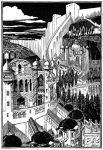
Illustration of Xanadu by Pattern Wilson (1898)
Back in the mid 1970s there was a flat called Xanadu at 3 Eden Street. The name was painted in an Asiatic typeface in black on the white front door. The flat adjoined a corner store run by the Verkerk family.
The origin of the flat’s name may be lost in the mists of time but is has been suggested it had its origins in the poem Khublah Khan written by Samuel Coleridge, in an opiate haze c.1797 [1].
Whether or not this is the case, the flat was certainly around too early to be named for the 1980 roller-opera starring Olivia Newton John, and the hit song of the same name written by Jeff Lynne.
Eden Street no longer exists but was only a couple of blocks from the main University campus to the west. The street was built over in the redevelopment of the intersection of Union and Eden Street when Otago Polytechnic was expanding. The flat would have been where H Block is currently situated.
The original location of Eden Street can still be seen in a map (below) from the DCC Rating Information Database.
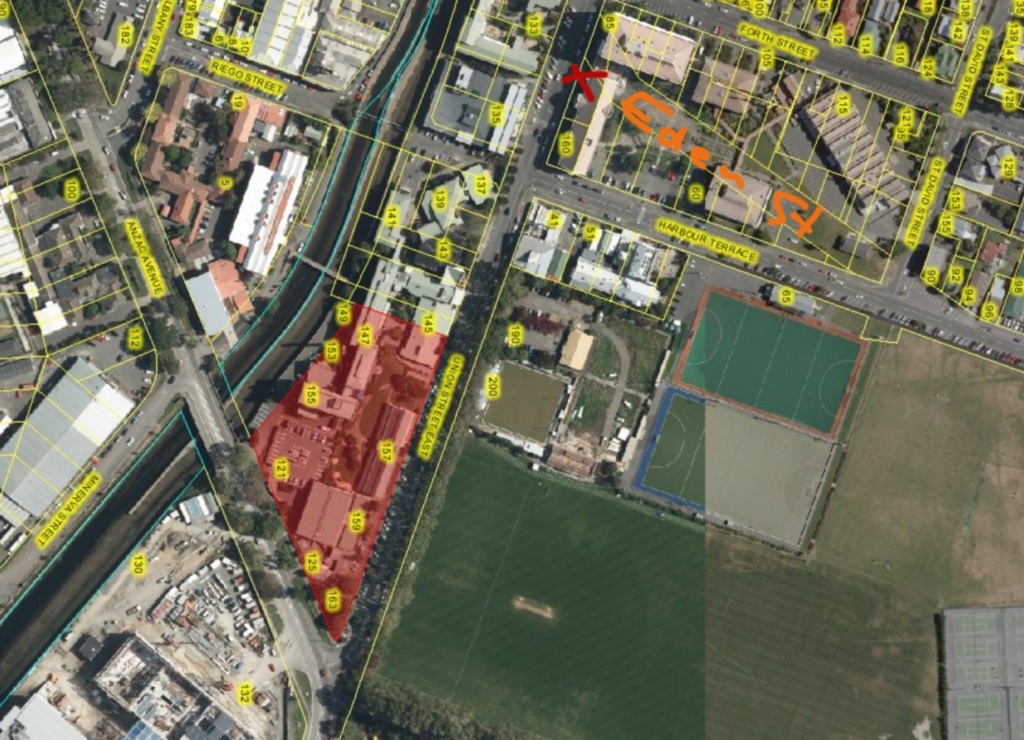
View of Eden Street. Map from DCC Rates Database, modified by Judy Fisher.
The photographs below show the intersection of Union and Eden Streets with Verkerk’s store on the left and Xanadu adjoined, and the photograph of flatmates outside their named flat are taken in 1976. Judy Fisher (third from the left), a resident of Xanadu from 1976-1977 remembers:
“We walked out of that door turned hard left and back into the shop, where they made the most amazing bacon burgers and chips … Mrs Verkerk always remembered us all 20+ years later, when she was in the new store ( which her son owns now).”[2]
The family shop, known as the Campus Wonderful Store is still 138 Union St where it’s been feeding local students with pies, chips and grocery items for decades.[3]
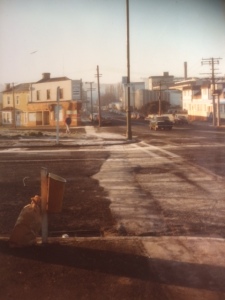
Photo taken from the intersection Forth and Union Sts looking towards the site of the flat Xanadu (yellow building) and the Verkerk’s store on the corner of Eden and Union Sts. Image source: Verkerk Family (via Judy Fisher)

Flatmates outside Xanadu, 3 Eden Street (1976). Image Source: Judy Fisher
References
[1] Holmes, Richard. Coleridge: Early Visions, 1772–1804. New York: Pantheon, 1989.
[2] Fisher, J. Email 23 May 2016
[3] The Verkerk’s intend to build a new store on site with apartments above. See Corner building opponent’s concerns dismissed, ODT 10 November 2016.
Hobbit, 575 Cumberland Street #flatnames
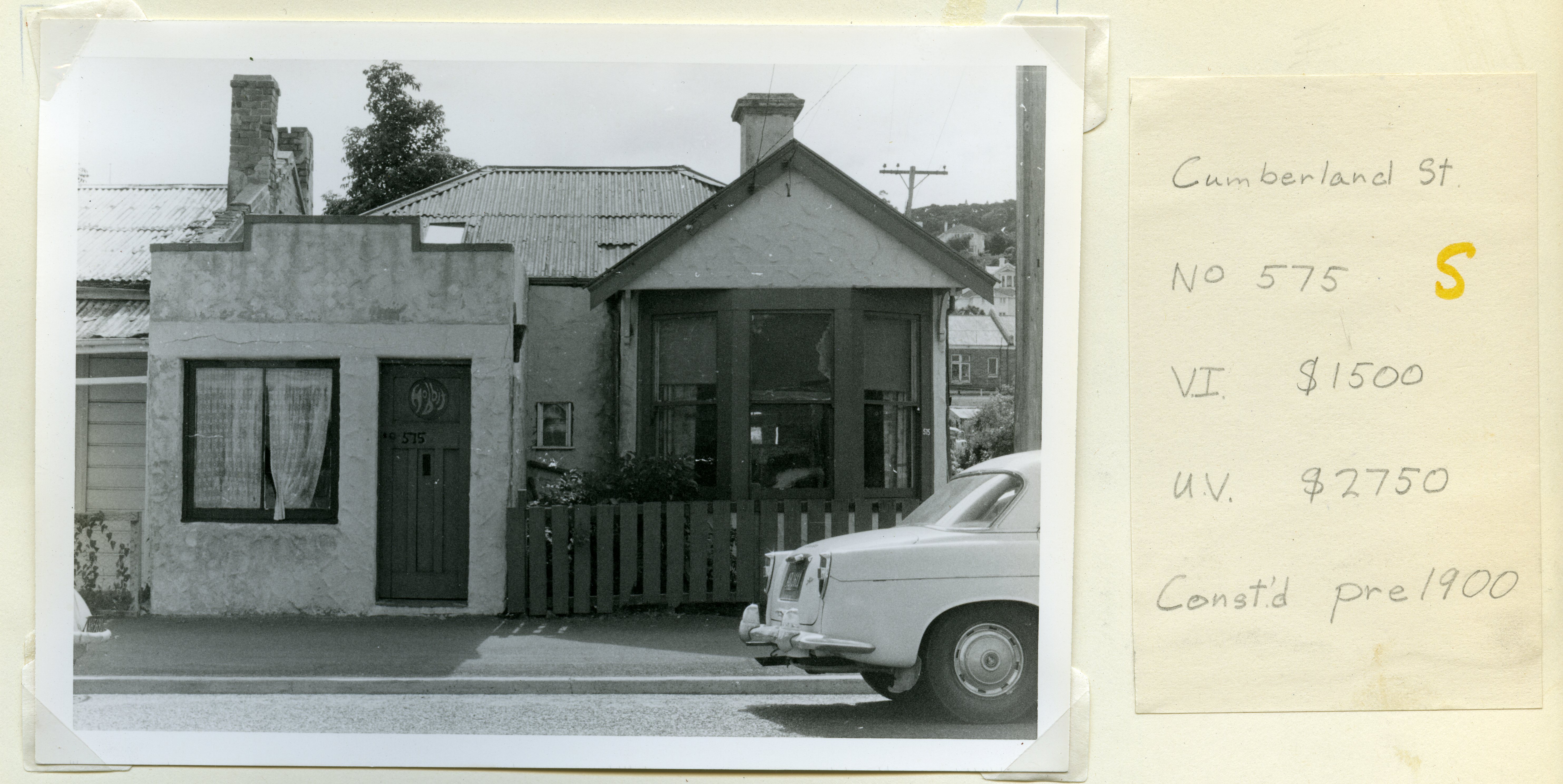
“Hobbit” flat. Built 1901, demolished 1970s. DCC Archives, City Engineers Album – Cumberland/Castle Street Deviation, 1973
575 Cumberland Street doesn’t exist anymore, it was demolished in the 1970s when Castle and Cumberland Streets were deviated to their current course. Below you can see photos of a couple of hand drawn maps. The first, a detail, shows 575 Cumberland highlighted in green. Compare the larger hand drawn map (note the green on this larger map is NOT 575!) with the image from the DCC Webmap. You should be able to see the site of 575 Cumberland Street two sections south of 58 Albany Street.
Many thanks to the DCC Archives for providing these images.
Correspondence: from letters to emails, from letterhead to Facebook #flatnames
The means by which we correspond or communicate, in written form, has changed immeasurably in the last 20 years. Personally I barely put pen to paper, and when I do now, it is a card rather than a letter that I am usually writing. When I started University in 1991 I paid $50 a week for my room in a four person flat, and spent a further $5 a week on stamps. I wrote long letters to friends and family, and received many letters in return, often addressed to me at my flat, Mouse House, at 888 Cumberland Street.
In the 1940’s the residents of The Bach, at 208 Leith Street, designed a crest and motto and had letter head printed. Examples of the letters written by Bachite David Gardiner, to the Board of Divinities, can be seen in the Presbyterian Archive at Knox College.
In the 1960s a flat called Che Choux at 64 Heriot Row (“Cabbage House”, named for the Cabbage Tree in the front garden) also had letterhead which was printed at the Christ’s College Press. Unfortunately there are no copies of the letterhead available in their archives.
In the early 1970s a flat called The Spanish Slum, 16-18 London Street, also had letterhead, though it is unknown where this was printed.
It is interesting to see the shift in personalisation of communication forms from a hard copy print environment, to the digital; from email, to social media where platforms like Facebook suddenly make it very easy to communicate with many people simultaneously. Where once flats went to the extent to have letterhead designed and printed, today’s students can easily set up a Facebook page for their flat. There are several examples, of this practice, such as The Chateau at 47 London Street, The V Flat at 97 Dundas Street and the 8 Man at 627 Castle Street.
Did you have letterhead or a Facebook page for your student flat, or do you know of a flat that had letterhead or has a Facebook page? If so, I’d love to hear about it.
Flat names trickling in
It’s amazing. I’m the grateful recipient of a growing treasure trove of stories, information and photos about past named flats in Dunedin – the stories are mostly coming arriving from alumni of the 1960s and 1970s and you’ll see a few posts below where I’ve started listing these names, and the addresses if I have them). There’s a few from the 1990s too.
820 members of the FB group.
Do you remember the 1970s in Dunedin?
Do you remember or have any detail about these flats, or others from this period?
Gilgamesh (Castle St), Nightmare Abbey (Castle Street), Hobbit’s Hovel, The Bay of Pigs (Cumberland St), Convention Centrewhich (Cumberland St), Toad Hall (Pitt or Cumberland St), Mustart Mansion, Ratvia, Slagg Heep (158 Dundas Street), Toad Works , Acropolis (Clyde Street), The Spanish Slum (16-18 London St)
